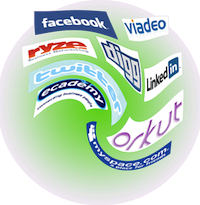Social Networks and the Relationship Life Cycle: Myths and Realities shows how to use social networks to lower the costs of the four stages of developing relationships.
Contradictions Abound—What Seems New Is Ancient—Sorting through the Clutter to Create Value
 Digital social networks are transforming every field of human endeavor, from society and romance to politics and business. This is happening because they change the economics of how people discover, develop and maintain relationships. Although some will argue this point, we humans share with other animals the propensity to take more of something desirable when given the chance, and social networks enable us to have more relationships.
Digital social networks are transforming every field of human endeavor, from society and romance to politics and business. This is happening because they change the economics of how people discover, develop and maintain relationships. Although some will argue this point, we humans share with other animals the propensity to take more of something desirable when given the chance, and social networks enable us to have more relationships.
However, as I predicted in the Web 2.0 Adoption Curve, 2009-2015, there will be a significant backlash against social networks during 2009-2010 because the market’s perceived value of social networks is much higher than its skill with the tools. This will result in inflated expectations and ensuing disappointments. Most executives are distracted by social networks’ strangeness and features, and they miss the obvious, that social networks offer a quantum leap in productivity for developing and managing relationships. Much of the market will reject social networks as a fad and will sit on the sidelines during the Failure & Disappointment part of the adoption curve. However, people and companies that understand the real proposition will develop a rare competitive advantage while competitors are snoozing.
Social Networks Myths and Realities
I have advised several companies and hundreds of individuals on using LinkedIn, Facebook, Twitter and others over the past three years, so I have a large sample of helping pioneers to create business value from social networks. I see numerous patterns and myths distract people from realizing value. Here is a sample:
Myth |
Reality |
| Social networks are power tools; just push the button and you can sell more easily | Social networks are a means to developing relationships, which is hard work |
| Social networks are a technology that will drastically improve productivity | Social networks are technology tools, but their value lies in trusted relationships, which have nothing to do with technology |
| Having a lot of friends, followers, connections will get me a job or new clients | The number is less important than building your network with purpose and engaging your network in your goals |
| Hollywood stars, sports figures and politicians are using social networks, so I should use them, too | Celebrities are probably more clueless than average people about how to use social networks; they draw attention but serve as poor examples for most firms and people |
| Social networks are a waste of time, people do such stupid things like polls and games | Disruptive innovations require experimentation; social networks make interaction transparent; listen to people in break rooms and picnics; much of the content is goofing around |
| Social networks lead to more shallow relationships | Social networks are tools for relationship building whose results depend on their users |
| Social networks are addictive and dangerous | Humans can get addicted to anything, including social networks |
A Mass of Contradiction
 Social networks are eerie for some people because they digitize a part of something very personal, how people conduct their relationships. The behaviors are old (what’s more basic than creating relationship?), yet digital social networks are new (how do the tools work?). Yes, they are technology tools, but they merely automate some aspects of how people make and manage relationships. Most people are unaware of how they create and manage relationships offline, yet they must approach relationships with more purpose if they are to leverage the value from social networks.
Social networks are eerie for some people because they digitize a part of something very personal, how people conduct their relationships. The behaviors are old (what’s more basic than creating relationship?), yet digital social networks are new (how do the tools work?). Yes, they are technology tools, but they merely automate some aspects of how people make and manage relationships. Most people are unaware of how they create and manage relationships offline, yet they must approach relationships with more purpose if they are to leverage the value from social networks.
The stakes are high. The firms that use social networks to reduce their sales cycle Discovery process by (roughly) 30% will have a significant competitive advantage. I predict similar benefits after Discovery in the business development cycle.
This revolution in communication is similar in scope to Ford’s invention of the assembly line for fabrication.
The Relationship Life Cycle
Relationship building rarely gets enough attention in discussions about social networks, so I’ll emphasize it here. What hasn’t changed is that you get out of relationship building what you put into it. If you use a superficial approach, you will develop superficial relationships. One of the most uncanny things about social networks is that they make private things public, they increase transparency of relationship building.
The Relationship Life Cycle
- Discovery: with whom should I connect and why?
- Invitation: I found someone I’m interested in, how do I initiate a relationship?
- Building: how do I develop a relationship?
- Management: how do I keep up my relationship?
 For virtually all of human existence, we did not choose our relationships; they were a function of proximity (more on this here). Family, location and social standing pre-determined with whom we interacted and how. Today, we have unprecedented choice, but that confronts us with deciding whom want as connections, finding them and building relationships. Building relationships has never been easy, and few people are good at it because they haven’t had to be since social structure determined connection. Digital social networks make this easier but more explicit. For example, you have a colleague you’d like to ask out for a drink, so you ask him/her and this is successful or not. Your request takes a moment, and you are largely unaware of it. In a social network, you record your request in writing or other means, and this is more explicit.
For virtually all of human existence, we did not choose our relationships; they were a function of proximity (more on this here). Family, location and social standing pre-determined with whom we interacted and how. Today, we have unprecedented choice, but that confronts us with deciding whom want as connections, finding them and building relationships. Building relationships has never been easy, and few people are good at it because they haven’t had to be since social structure determined connection. Digital social networks make this easier but more explicit. For example, you have a colleague you’d like to ask out for a drink, so you ask him/her and this is successful or not. Your request takes a moment, and you are largely unaware of it. In a social network, you record your request in writing or other means, and this is more explicit.
How Social Networks Affect the Life Cycle
- Discovery is getting much easier. As people have more interactions on digital social networks, they are easier to find based on specific search criteria. If you are looking for prospects who have specific business challenges, it can help you to find them when they talk about their problems in blog posts or responses of LinkedIn Answers.
- Invitation is more explicit and therefore more uncomfortable for many people. But it is much faster, and it is often successful when you are sincere, forthright and offer something in which the other person is interested. Most people invite people using social networks’ default invitations; in other words, they don’t personalize their invitations. They also don’t communicate an explicit purpose behind their invitation, even though they have some unconscious motivation.
- Building is also largely an unconscious process for people, whether in a social network or not. You build relationships through interacting, and each interaction either increases or decreases trust. Therefore, when you approach your interactions with this purpose, you will be more successful. Interactions in social networks are less costly than other means. For example, having a 30 minute phone call will likely take you as long to arrange. Much of the call will be “small talk” updating each other on what’s happened since you talked last. Each interaction contains many channels, but let’s focus on two: you show you care about the person, and you explore areas of mutual interest. In a social network, you can communicate that you care about someone by helping them do something they care about (connect them with someone or answer their question). You can learn more about areas of mutual interest by looking at each other’s profiles. When you do meet face to face, you can have much better conversations because you can focus more.
- Management is much more leveraged in a social network. LinkedIn, for example, alerts you when your Connections change their profiles (get new jobs, work on new projects…). One click shows you their profiles. Facebook and Twitter offer more real-time updates on what people are thinking and doing. Using social networks, you can keep in touch with a far larger network. Whether you are fighting to eradicate cancer, looking for funding for your latest startup or seeking a new job, having a larger network can enable you to succeed much more than others with smaller networks. Social networks strengthen your offline interactions; they do not replace getting across the table from someone, but you do have to choose with whom you have these precious offline interactions.
More Relationships: Confounding Dunbar’s Number
 Having more relationships confronts us with our brains and value systems, which were formed when we had access to far fewer people. Dunbar’s Number holds that humans can “maintain stable social relationships” with about 150 people. He defines that as remembering important things about each of those people, including whom they know and how. His research connects the number with neocortex size. When we talk about having networks many times larger than that, we run into problems. We can’t remember the details, and we deal with this in different ways. Some people try to game the number through mental gymnastics, and many people use digital devices. Traditionally, we have had relationships in the following categories, each of which has socially defined expectations and commitments:
Having more relationships confronts us with our brains and value systems, which were formed when we had access to far fewer people. Dunbar’s Number holds that humans can “maintain stable social relationships” with about 150 people. He defines that as remembering important things about each of those people, including whom they know and how. His research connects the number with neocortex size. When we talk about having networks many times larger than that, we run into problems. We can’t remember the details, and we deal with this in different ways. Some people try to game the number through mental gymnastics, and many people use digital devices. Traditionally, we have had relationships in the following categories, each of which has socially defined expectations and commitments:
- Family
- Colleagues (work)
- Friends (neighbors, school friends)
- Worship
- Hobbies
What if we created different categories? The trick is, we need to be authentic by not pretending that the extra people have the same commitment levels and expectations as the others. This is so new that people don’t know what to do with it. Here is a representative list (Assume that they are not included in the above):
- Networking people you meet at business functions
- Social network connection who answered one of your questions in LinkedIn Answers
- Social network connection with whom you’ve exchanged compliments on each other’s jokes
- Social network connection with whom you’ve exchanged a dozen pertinent articles
 In other words, there is much opportunity when we “add columns to our databases” to make room for new categories of people. If we are honest and authentic, we can benefit from the increased connections. Dunbar’s Number shows that we have limitations, so acknowledging them while authentically sharing with people offers opportunity. No matter what is important to you, personally or professionally, other people can help you. For example, if you are looking for a job or a new client, you need access to people who can hire you as an employee or consultant or you need expertise to explain how what you offer relates to target companies. A larger network affords you more access and expertise, but networks are like gardens, they need tending.
In other words, there is much opportunity when we “add columns to our databases” to make room for new categories of people. If we are honest and authentic, we can benefit from the increased connections. Dunbar’s Number shows that we have limitations, so acknowledging them while authentically sharing with people offers opportunity. No matter what is important to you, personally or professionally, other people can help you. For example, if you are looking for a job or a new client, you need access to people who can hire you as an employee or consultant or you need expertise to explain how what you offer relates to target companies. A larger network affords you more access and expertise, but networks are like gardens, they need tending.
Conclusions
- Social networks reduce the cost of the relationship life cycle, but most people don’t know how to use the tools or how to act in this new environment.
- Many executives remark to me that social networks are an appalling waste of time, judging by the silly activities that go on. I remind them that very few people know how social networks work or what to do with them; therefore, expect extensive experimentation, but don’t be put off by behavior of which you disapprove; no one said you had to behave like others.
- If you focus on developing relationships based on authentic interactions, you can develop and manage a larger network. Your network can help you accomplish more of what’s important to you. For more on this, see How Social Networks Make Markets More Efficient for Buyers and Sellers.
- Connecting with people is the first step, but you must have meaningful interactions with them to develop and maintain the relationship.
- Sharing and exchanging on a social network is faster, easier and less costly than offline.
- To optimize the value you can create with social networks, you need to create additional categories for people, and you need to be authentic about how you interact with them. This is not easy because people have different expectation levels. We are making up our own rules as we go along because this is new.

Christopher,Thank you for sharing your brilliant observations on the myths and realities of social media. Ask any master craftsman, because you own a tool does not mean you can build something of value. It is no different for social media/networking. I agree with your observation that the discovery process is expedited, but if nothing comes from the discovery then you have not accomplished much. Connecting and building relationships is the essence of engaging and building meaningful relationships. Thanks again, I look forward to reading more of your work.
Kind regards,
Jim
Jim, thanks for writing. Another way I think about it is that tech tools only introduce tweaks to how we do things, even though the tweaks can be profound, as with social networking. But the core activity is the same, building relationship. It always comes down to understanding what’s new, and how it applies to what’s come before.
Chris:
Your four stage Relationship Life Cycle is incredibly powerful in its simplicity. It can be difficult to create and manage high quality positive relationships if individuals do not consistently practice the common body of knowledge principles of respect, support, accountability, responsibility, etc. As has been noted by some thought-leaders, on-line social networking platforms give the illusion of a relationship. Your process combined with core principles, kept-commitments, and strong perceptions will ensure that the individual creates and grows their relationship capital for their personal and professional success. You continue to earn relationship capital from me with your contributions. Thank You
[…] cut the cost of communication ten-fold, so they transform relationships. This means that the relationship life cycle moves ten times faster, from discovering specific types of people and initiating relationships to […]
[…] technologies is starting at their foundation: communication. It is transformational to digitize the relationship life cycle. People, regardless of the activities they pursue, can find and collaborate with other people with […]
[…] None of these “features” are unique in themselves, but by bundling them together in the first-to-market offer, Twitter has created the microblogging niche in the Web 2.0 ecosystem. Twitter can be used to accomplish many types of objectives (i.e. sales, promotion, marketing), but I’ll argue from the point of view that it is transforming the relationship life cycle. […]
[…] Social business is the present and future. It differs from social media explicitly and implicitly. Its explicit difference is that it focuses on interaction and collaboration while “content” takes the back seat. Therefore, its core activity is the polar opposite of social media. Social business practitioners relate to people by listening, suggesting, supporting and collaborating. Social business changes the economics of relationship itself because it lowers the cost of each stage of the relationship life cycle by an order of magnitude: discovering, inviting, building, maintaining and transitioning. Dive deeper in Social Networks and the Relationship Life Cycle. […]
[…] MUST READ—Countering Social Networks’ Unique Challenges with the Relationship Life Cycle […]
[…] Social business is the present and future. It differs from social media explicitly and implicitly. Its explicit difference is that it focuses on interaction and collaboration while “content” takes the back seat. Therefore, its core activity is the polar opposite of social media. Social business practitioners relate to people by listening, suggesting, supporting and collaborating. Social business changes the economics of relationship itself because it lowers the cost of each stage of the relationship life cycle by an order of magnitude: discovering, inviting, building, maintaining and transitioning. Dive deeper in Social Networks and the Relationship Life Cycle. […]
[…] Taking risks by sharing intimate details, and watching how others respond, is the cornerstone of trust and relationship building. Surprising to most businesspeople is that taking care of customers when “accidents” […]